Flushing the heating system: how to clean the pipes and
For normal operation of the heating system in a private house or city apartment, the heating network must not only be properly designed, but also properly maintained. In particular, regular flushing of the heating system is necessary. For information on what technical tools are used for this and what kind of reagents help facilitate the work, read below.

Need cleaning
Flushing of heating systems is an obligatory measure, without which the normal functioning of climate networks is impossible. This requirement is fixed by the SNiP 3.05.01-85 “Internal sanitary and technical systems”, which set the rules for the operation of indoor climate control networks. The frequency of flushing the heating system is also determined there.
Due to ongoing cleaning, mineral deposits and dirt are removed from pipelines and radiators, which can lead to a decrease in the efficiency of the heating network, as well as blockage of the entire system or its individual parts.

The instruction for flushing heating systems provides for this event for apartments with a centralized coolant supply network, and for dwellings equipped with autonomous boilers, regardless of the capacity and performance of the installed equipment.
Washing Methods
Chemical
Flushing heating with special chemicals is the most effective and least time-consuming method of cleaning pipes and radiators. Special reagent allows you to quickly and efficiently get rid of mineral deposits on the inner surfaces of all elements of the heating network.
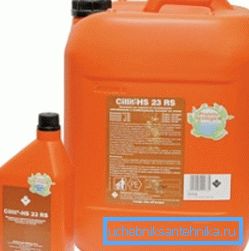
Chemical flushing of heating systems does not require the use of complex equipment, however, it allows you to effectively restore the permeability of all pipes, which significantly improves heat transfer and reduces the load on the boiler.
Specialized stores sell the following types of pipe cleaning products:
- alkali based;
- solvent based;
- acid based.
Note! Recently, a compositional fluid for flushing the heating system is gaining more and more popularity, which allows to achieve better results, having the least negative impact on the equipment of the heating system.
The main disadvantage of this cleaning method is the toxicity of the solutions. When using them, rubber gloves and respiratory protective equipment and mucous membranes must be used. It is also important that the pipelines do not leak, as toxic liquid can leak into the living quarters or into the sewage system, causing mass poisoning.
Remember that using potent chemicals is not allowed to flush aluminum radiators. This material will not withstand the aggressive effects of the solution.
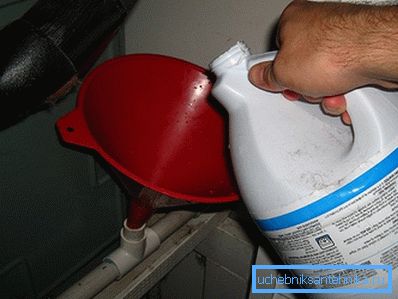
To clean pipes with chemicals you will need:
- special hoses;
- water pump;
- tank for collecting fluid;
- necessary reagents (they are sold in the form of powders that need to be diluted with water or ready-to-use solutions).
The chemical cleaning process itself takes up to several days and can be carried out even when the heating system is in operation.
Hydrodynamic
This technology of flushing the heating system involves the use of special devices equipped with nozzles that supply water under a pressure of more than 200 atmospheres.
With the help of hydrodynamic nozzles from the heating system are removed:
- chemical impurities;
- residues of coloring matter;
- soot;
- scum;
- traces of corrosion;
- organic fats.
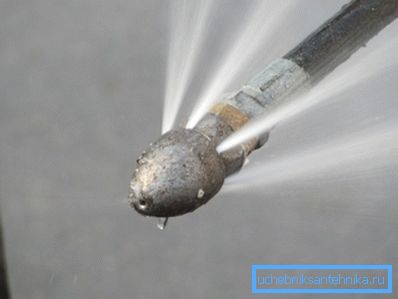
Water jets under very high pressure efficiently flush the heating pipes and cast-iron radiators, which are part of a centralized coolant supply network (in urban apartments).
Cast iron batteries are among the most efficient and widespread devices for heat exchange. However, due to the corrosive instability of this material and the far from ideally smooth inner surface of radiators, they very quickly become clogged with mineral deposits. This is the reason for the reluctance of most consumers to use such products for the design of heating systems.
However, a simple hydrodynamic washing of radiators completely eliminates the disadvantages listed above. The strong pressure of the water relieves the battery of any deposits and 100% restore the efficiency of the climate network.
Another very important point - environmental friendliness. The heating system is cleaned without the use of any chemicals that may harm equipment, human health or the environment. The pump is fed only pure water, devoid of any impurities.

The disadvantage of this method is the need to dismantle the radiators before processing. They must be subjected to a special procedure that softens deposits, which cannot be done in a dwelling.
Note! The instructions for flushing the heating system using hydrodynamic heads are quite complicated, you can hardly do the job yourself, even by purchasing or renting the necessary equipment. It is better to contact a specialized company, especially since the price of their services is not very high.
Pneumohydro pulse
This is another means by which you can easily restore the efficiency of the heating system. In this case, special equipment is also used for the procedure - water pneumatic pistols.
It is a compact device that is easy to transport and use. The advantage of this method is that it can get rid of mineral deposits located at a distance of up to 50 meters from the point of application of the pulse.

However, air guns are effective only if the diameter of installed pipelines does not exceed 150 mm. On the other hand, all procedures are performed without dismantling pipes, batteries and other equipment, which reduces the time and reduces the complexity of the procedure.
The main element of the pneumohydraulic installation is the compressor.
There are two main types:
- devices that supply clean water;
- liquid injection units with large amounts of air.
It is also advisable to select a device equipped with the following elements:
- liquid flow meter;
- pulse pressure indicator;
- protection against spontaneous inclusion;
- a container that allows you to add powders, disinfecting pipes and radiators to the supplied liquid.
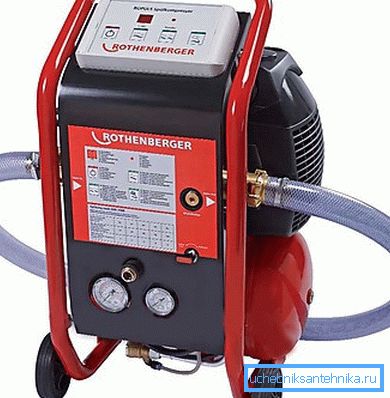
Tip! For your own needs, you should not buy a powerful and bulky device with a variety of modes of operation. You simply can not manage it. It is better to opt for more affordable and easy-to-operate compressors. Their capacity will be enough to maintain the pipelines in your house in perfect condition.
After the impulse cleaning in the heating system, the characteristics that were inherent in it immediately after the completion of installation are restored. In addition, so you extend the life of all its elements without the need for major repairs. And, of course, you make it more economical, reducing energy consumption for the production of the same amount of heat.
Procedure for cleaning the heating system
The scheme of flushing the heating system with the help of chemicals is the simplest.
That is what we consider:
- First of all, shut off the valve through which the coolant is supplied to the heating system. After that, you need to turn off the electricity supplying the boiler and circulation pumps.
- Having opened the water release valve, it is necessary to drain the coolant into the sewage system.
- In order to speed up this process, it is advisable to completely unscrew the air valves through which the system is disinfected. It is not necessary to do this on each radiator; it is enough to dismantle the Mayevsky cranes from the radiators located in the upper part of the system.
- A fluid is then injected that contains chemicals that facilitate flushing. This should be done until clean water flows from the drain valve.
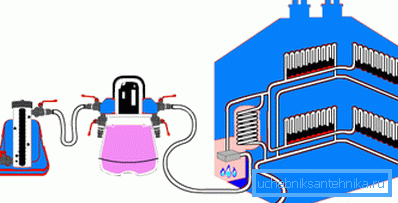
Note! Discharge of the used liquid cannot be carried out into the sewage system, as aggressive acids or alkalis in it can destroy the plastic pipes of the sewer network and lead to poisoning of the inhabitants of a house or apartment.
- At the end of the washing process, the system is filled with coolant again. To avoid the rapid formation of scale and rust, so-called corrosion inhibitors can be added to the liquid. It is necessary to fill this substance through the uppermost air valve.
- You can monitor the completeness of the filling with a pressure gauge indicating the pressure in the system. If your heating system is equipped with an open expansion tank - water must be poured until it reaches half of this capacity.
Conclusion
For the smooth operation of the heating system, it is important not only to clean the pipe from scale. It is also necessary to monitor the operation of the heating boiler, carry out periodic maintenance of circulating water pumps, conduct an audit of the pipe joints for leaks and other things. In more detail about all the procedures you can learn from the video in this material.